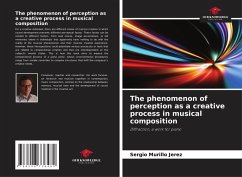
Features Of The Perception And Construction Of Melodies
Versandkostenfrei!
Versandfertig in 6-10 Tagen
59,90 €
inkl. MwSt.

PAYBACK Punkte
0 °P sammeln!
Most people in the Western world listen to music because of emotions. They want to create or experience emotions. But music is made of tones, tones are sound waves and sound waves are physics. How is it possible that physics becomes psychology, because emotions are a psychological phenomenon? When people like a certain piece of music, they usually want to listen to it again and again. Not infrequently for years and decades. What could be the reasons for this? When people like a piece of music, it is primarily the melody that they like. For most people, the melody is the face of a piece. More t...
Most people in the Western world listen to music because of emotions. They want to create or experience emotions. But music is made of tones, tones are sound waves and sound waves are physics. How is it possible that physics becomes psychology, because emotions are a psychological phenomenon? When people like a certain piece of music, they usually want to listen to it again and again. Not infrequently for years and decades. What could be the reasons for this? When people like a piece of music, it is primarily the melody that they like. For most people, the melody is the face of a piece. More than anything else, it is the element of music they remember. What are the characteristics of melodies that make them to be remembered by listeners? What features of the melody could it be that ensure being liked by listeners? Based on more than 300 keywords, over 160 musical examples, and 39 charts, answers to these and many other questions are sought and offered in this book. This book is always two-in-one. By illuminating how melodies are built that enjoy great popularity, it is a book of music theory. In this way, it addresses readers who are primarily interested in the book because they themselves invent melodies. By illuminating what psychological mechanisms and physiological responses trigger the melodic operations of composers and improvisers, it is an introduction to music psychological thinking. It combines fundamental considerations from cognitive science, psychology, anthropology, and linguistics. Thus, it is addressed not only to music theorists and musicologists, but ultimately to all readers who wish to expand their knowledge of how melodies work.












